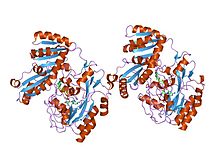Lactic dehydrogenase
Lactate dehydrogenase (LDH or LD) is an enzyme found in nearly all living cells (animals, plants, and prokaryotes). LDH catalyzes the conversion of lactate to pyruvic acid and back, as it converts NAD+ to NADH and back. A dehydrogenase is an enzyme that transfers a hydride from one molecule to another.
LDH exist in four distinct enzyme classes. This article is specifically about the NAD(P)-dependent L-lactate dehydrogenase. Other LDHs act on D-lactate and/or are dependent on : ) and L-lactate ().
LDH is expressed extensively in body tissues, such as blood cells and heart muscle. Because it is released during tissue damage, it is a marker of common injuries and disease such as heart failure.
Lactate dehydrogenase catalyzes the interconversion of pyruvate and lactate with concomitant interconversion of NADH and NAD+. It converts pyruvate, the final product of glycolysis, to lactate when oxygen is absent or in short supply, and it performs the reverse reaction during the Cori cycle in the liver. At high concentrations of lactate, the enzyme exhibits feedback inhibition, and the rate of conversion of pyruvate to lactate is decreased. It also catalyzes the dehydrogenation of 2-Hydroxybutyrate, but it is a much poorer substrate than lactate.
LDH in humans uses His(193) as the proton acceptor, and works in unison with the coenzyme (Arg99 and Asn138), and substrate (Arg106; Arg169; Thr248) binding residues. The His(193) active site, is not only found in the human form of LDH, but is found in many different animals, showing the convergent evolution of LDH. The two different subunits of LDH: LDHA also known as the M subunit of LDH, and LDHB also known as the H subunit of LDH both retain the same active site, and the same amino acids participating in the reaction. The noticeable difference between the two subunits that make up LDH's tertiary structure is the replacement of alanine (in the M chain) with a glutamine (in the H chain). This tiny but notable change is believed to be the reason the H subunit can bind faster, and the M subunit's catalytic activity isn't reduced when subjected to the same conditions as the H subunit; while the H subunits activity is reduced fivefold.
...
Wikipedia





